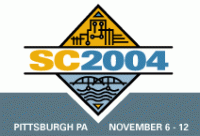HPCの歩み50年(第112回)-2004年(i)-
SC2004についてその3。Seymour Cray Computer Science and Engineering Awardは Dr. William J. Dally (Stanford University)が受賞した。地球シミュレータは3年連続でGordon Bell賞を受賞した。バンド幅チャレンジでは日本の関係したグループが受賞6件中3件あり頑張った。最終日のパネル“HPC Survivor— Outwit, Outlast, Outcompute”に松岡聡が出演し大奮闘した。

SC2004(続き)
14) Computing Opportunities in the Era of Abundant Biological Data
11日(木)の朝一番の招待講演はGane Ka-Shu Wong (Associate Director, Beijin Institute of Genomics)であった。途中からしか聞いていないが、ゲノムのデータを処理するのにHPCが重要であることを豊富な絵で強調していた。ずいぶん英語がうまいと思ったら、もともとアメリカ生まれで、北京の研究所にスカウトされたらしい。
15) Computing — An Intellectual Lever for Multidisciplinary Discovery
2つ目の招待講演はDaniel A. Reed (Director, Renaissance Computing Institute–Duke, UNC and NCSU)で、前述のように前年末までNCSAの所長であった。てこの原理を発見したアルキメデスは、「我に足場を与えよ。しからば地球を(てこで)動かしてみせる」と言ったそうであるが、HPCはいまや全科学技術を動かす知的なてこである。
重要なことは「夢をもつ」ということである。動物は夢を見ない。そして夢を社会的なプロセスとして実現することである。コンピューティングの世界の夢とはなにか。たとえばイリノイ大学のPLATO (1970-85)はタッチパネル式で子供でも使えるコンピュータを目指した。IBM のSTRETCHは、IBM704の100倍以上速い計算機を目指した。これは1964年までの最高速の計算機であった。
生物進化にCambrian Explosionがある。大部分の無脊椎動物が急激に出現し、三葉虫が栄えた。条件が整えば変化は早い。
21世紀のチャレンジとは何か。理論・実験・計算のthreefold wayである。たとえば海岸地域の人口増大と経済と健康管理、天候と経済損失など。multidisciplinary models, multilevel cellular simulation, genetics and disease susceptibility….
連結したチャレンジとしては、素粒子の標準模型と暗黒物質、LSST, LHC, QCD、望遠鏡など。すべて複雑なルネッサンス・アプリケーションである。最近10年に発展した。LCD (lowest common denominator)でプログラムを刷る必要がある。どんどん学際的になる。
科学計算には3つのツボがある。
1) domain-specific desktop toolkits,
2) laboratory systems (cluster),
3) large scale systems
創造性に人工的な障壁を作ってはならない(と言って、C. P. Snowの言葉を引用した)。二つの文化の出会いによって創造性が高まる。Art meets science. もっとも美しい式はオイラーの恒等式eiπ+1=0である。
人工的な障壁を作ってはならない(と言って、Bob Wilsonの言葉を引用した。(Bob WilsonはFermilabの初代所長で、議会で「加速器は国防に役に立つか」と質問され、「国防そのものには役に立たない。しかし、我が国を、守るに値するものとすることに貢献する。」と答えた有名な話。)
計算機の歴史は指数関数で増大する。しかも増加係数そのものが増えている。初期には7.5年で倍だったが、その後、…. 量的変化は質的変化をもたらす。天文学や生物や医学のイメージデータの増加。
計算機の6つの時代区分。
1) big iron
2) mainframe
3) WS
4) PC
5) Internet
6)implicit computing (21st century) = ubiquitous invisibility
探求の旅はvision and opportunityに満ちている。”Avoiding all risks is itself a risk.” 「あらゆるリスクを避けようとすることはそれ自体がリスクである」(Reed Theorem) 探求はresearch time tunnelである。つまり、playing with tomorrow’s technology today.
全体としてなかなかいい話だった。
16) 表彰式
表彰式は木曜日の1時15分から行われた。今年はアナウンスが徹底していなかったのか参加者も少なく、受賞者のno showも多かった。受賞者のデータがSCのサイトにある。NSFのJose Munoz氏の司会のもとに進められた。
(1) IEEEの賞
a) Sidney Fernbach Memorial Award: Dr. Marsha Berger, NYU/Courant Institute
彼女は、計算流体力学の専門家で、adaptive mesh refinementやCartesian mesh with cut-cellsなどのメッシュの技法を研究した。
b) Seymour Cray Computer Science and Engineering Award: Dr. William J. Dally, Stanford University
今年は公表されていないが、じつは筆者はこの選考委員の一人であった(3年目)。Dally教授は、並列計算機のアーキテクチャ、とくに相互接続網の研究で知られている。研究用マシンとしては、J-Machine, M-Machine, and Imagineの開発に係わり、その成果はIntel iPSC, Ametek, and Cray T3D and T3E 等の商用マシンに適用された。
受賞者のプレゼンテーションで、”Supercomputer architecture, it’s about bandwidth, not MFlops” と述べた。Floating unitのコストは、$0.50/GF, 50mW/GFであるが、Bandwidthのコストは、$5/GBps, 0.25W/GBpsである。バンド幅のコストは距離とともに増加する。
階層によりバンド幅やレイテンシは異なるが、両者の積はほぼ一定である。LRF (256), SRF (192), cache (80), DRAM (200), Global memory (125)。conventional bandwidthはもっと悪い。今後は、bandwidth-centric architectureが重要である。
重要な決断事項は
parallelism (granularity, context, synchronization)
latency hiding
locality
である。locality requires both hardware and software。最後にもう一度 ”It’s about bandwidth, not Flops”と強調した。
(2) 論文賞
a) Best Technical Paper: “Assessing Fault Sensitivity in MPI Applications”
Charng-Da Lu (University of Illinois, Urbana-Champaign) and Daniel Reed (University of North Carolina at Chapel Hill)
秘密かもしれないが、朴泰祐はこの選定委員の一人であった。
b) Best Student Technical Paper: “Analysis and Performance Results of a Molecular Modeling Applications on Merrimac”
Mattan Erez, Jung Ho Ahn, Ankit Garg, William J. Dally, Eric Darve (Stanford University)
c) Best Research Poster: “The Next Generation of the Java CoG Kit”
Gregor von Laszewski et al.
(3) 性能に関する賞
a) Gordon Bell Awards:
(1)Peak Performance 賞:“A 15.2 TFlops Simulation of Geodynamo on the Earth Simulator,”
Akira Kageyama, Masanori Kameyama, Saturo Fujihara, Masaki Yoshida, Mamoru Hyodo, and Yoshinori Tsuda (Earth Simulator Center, JAMSTEC)
地球シミュレータは2002年以来3年連続受賞である。
(2)Special Category賞: “Ultrascalable Implicit Finite Element Analyses in Solid Mechanics with Over a Half a Billion Degrees of Freedom,”
Mark F. Adams (Sandia National Laboratories), Harun H. Bayraktar (Abuqus Corporation), Tony M. Keaveny (U.C. Berkeley), Panayiotis Papadopoulos (U.C.Berkeley)
b) HPC Software Challenge:
(1)The Trilinos Package Architecture and Infrastructure, presented by Michael Heroux, Sandia National Laboratories
(2)Improving Parallel Finite Element Method-Based Applications Through Software Engineering, presented by Dale Shares, US Army Research Lab
c) Bandwidth Challenge Awards:
(1) Entry name: A Framework of Cyberinfrastructure
Origanization: San Diego Supercomputer Center
Award: Best Spirit of the Challenge
(2) Entry name: All Roads Lead Through Chicago to Pittsburgh Performance Award
Organization: California Institute of Technology, Stanford Linear Accelerator Lab and Fermi National Lab
Award: Over 100 Gb/s per second aggregate memory to memory bandwidth utilizing the greatest number of networks
(3) Entry Name: Third Generation Data Reservoir
Organization: University of Tokyo
Award: Single Stream, Longest Path, Standard MTU TCP Throughput
Description: 7.2 Gb/s around the world
この平木さん達のグループは三回目の連続受賞である。平木チームは実験会場である展示場で徹夜で実験し、アラファトの死も知らずに冷たい床で仮眠をとる日々であった。「ホテル要らないんじゃない?」という心ないコメントも。グループのニュースリリースを参照。
(4) Entry name: National Center For Data Mining SC04 Bandwidth Challenge
Organization: National Center For Data Mining, UIC
Award: Best Replacement for FedEx UDP Fairness Award
Description: 800 Mb/s transferring astronomy data disk to disk
(5) Entry name: Showinig Bandwidth of CJK (China, Japan, Korea)
Organization: Kyushu University and KISDI
Award: Honorable Mention, Breaking Not Only Technical But Cultural Boundaries
(6) Entry Name: Effective Rapid Remote File System For Supercomputer Users Who Are Not Network Expert
Organization: JAXA
Award: Honorable Mention, Distributed Infrastructure Award
日本が関係したグループが、honorable mention (まあ「佳作」というところか?)まで含めれば6件中3件を占めたことはすばらしい。残念ながらhonorable mentionの日本の2ループは表彰式に姿を現さなかった。連絡が行き届かなかったようである。
d) StorCloud Challenge Awards
このchallengeには10件の参加があったが、入賞したのは以下の4件である。
(1) Best Random Access Use of StorCloud: Blockbuster, Lawrence Livermore National Labs.
(2) Best Use of StorCloud to Advance a Scientific Application: MPQC, Sandia National Labs.
(3) Most Innovative Use of StorCloud: PNNL Active Storage, Pacific Northwest National Labs.
(4) Highest Achieved StorCloud Bandwidth and I/Os per second: ENZO, San Diego Supercomputing Center.
17) Panels
12日(金)午前は、ナノテクのワークショップなどの他は、客受けを狙ったパネルが3並列で用意されている。筆者は松岡聡パネリストを応援するために後半10:30~12:00のパネルに出た
HPC Survivor— Outwit, Outlast, Outcompute
座長:Cherri M. Pancake (NACSE/Oregon State U)
パネリスト:Burton Smith (Cray, Inc.), Satoshi Matsuoka (Tokyo Institute of Technology), Jose Moreira (IBM), Rick Stevens (Argonne National Lab)
係員:Tony Hey (EPSRC and University of Southampton), Al Geist (Oak Ridge National Lab), Rusty Lusk (Argonne National Lab)
このパネルは、聴衆の拍手を「測定」して、その少ない順にパネリストを下していくという、どこかのテレビ番組みたいなパネルである。Cherri Pancake女史が考案したらしい。われわれは拍手要員を兼ねて参加した。出席者はかなり多かった。
各パネリストは、今後のHPCの方向性を一つ主張する。
#1 Burton Smith, Cray Inc.: Petascale, Flat Shared-Memory
#2 Jose Moreira, ANL: Billion-Processor Self-Assembled MPP
#3 Satoshi Matsuoka, TITech: Low-Power Commodity Cluster
#4 Pete Beckman: Kitchen-Sink Computing
それぞれのラウンドで二つの質問が出され、パネリストはそれに短く答える。そのあとで聴衆に拍手を求め、一番拍手の少ないパネリストが降ろされてexpertの席に移る、という趣向である。
a) 第1ラウンド
質問1:What is the biggest single advangtage of your approach?
質問2:What make your approach cost -effective?
それぞれが答えたあと、Tony Heyがコメント。ここで隣の部屋で別のパネルの司会をしているはずのDongarraが乱入。
質問3:HPC Challenge benchmarkをどう思うか
What metrics do you use?
ここで各パネリストがこの質問にもコメントした。
さて第1ラウンドの評価を拍手で測定した結果、Joseが降ろされ、expert席に移った。JoseはAl Geistのインタビューに「みんな誤解している!」
b) 第2ラウンド
質問1:What type of application will really “shine” on your architecture?
質問2:How has your approach been influenced by software constraints and requirements?
第2ラウンドの拍手の測定の結果、松岡が負けてexpertの席に移った。
c) 第3ラウンド
質問1:How is your architecture positioned to evolve in the future?
質問2:why is your approach better than the other remaining contestant?
また拍手の測定の結果、Burton が降ろされ、Peteが勝利者の王冠を与えられた。インタビューでBurtonは「おれが負けるはずはないのだが!」と不満そうであった。
最後に王冠をつけたPeteが船に乗せられ、無人島へ。”Aloha from HPC survivor island” という趣向。パネリストたちの記念撮影もあった。[各パネリストの回答も面白いのだがメモが不完全で今のところ再現できない。松岡は、ギャグの応酬のようなパネルによく対応していた。さすがバイリンボーイ。
次はアメリカの企業の動き。Hewlett-Packard社は64ビットサーバにOpteronを採用すると発表し、Itaniumの退潮を印象づけた。
(タイトル画像: SC2004ロゴ 出典:SC2004ホームページ)
 |
 |
 |

